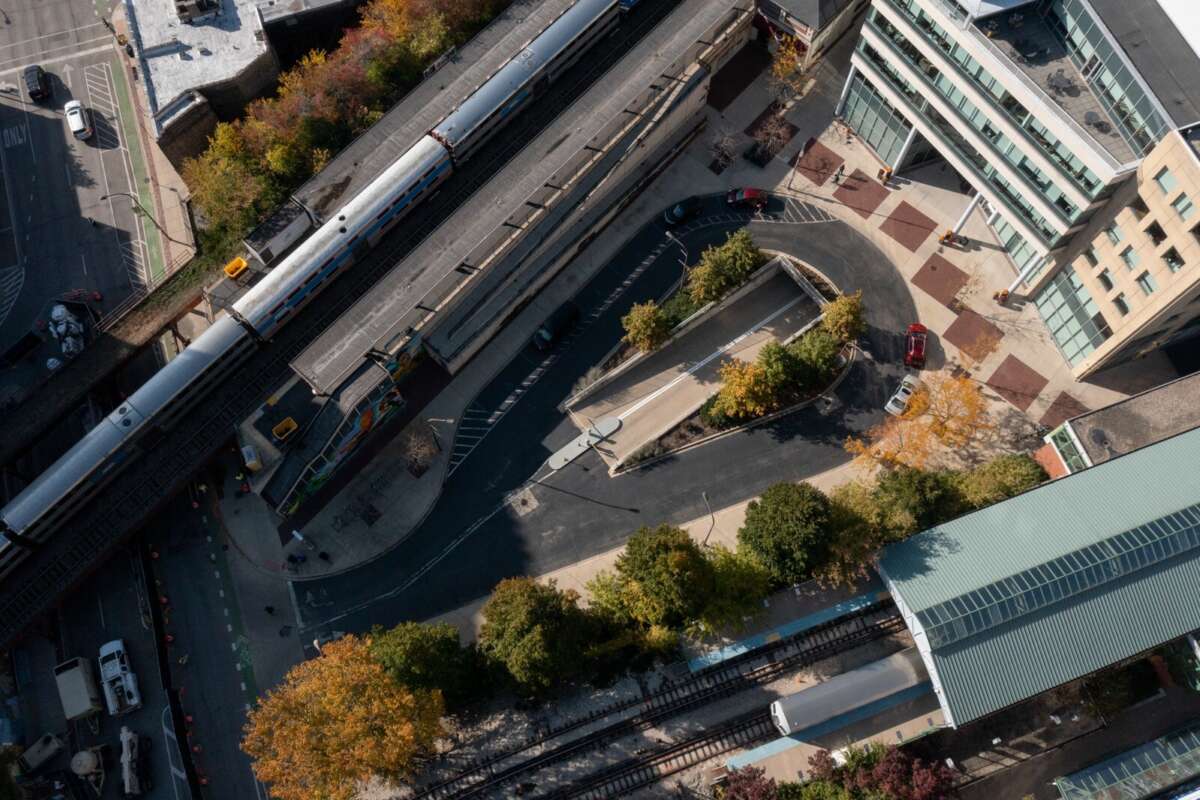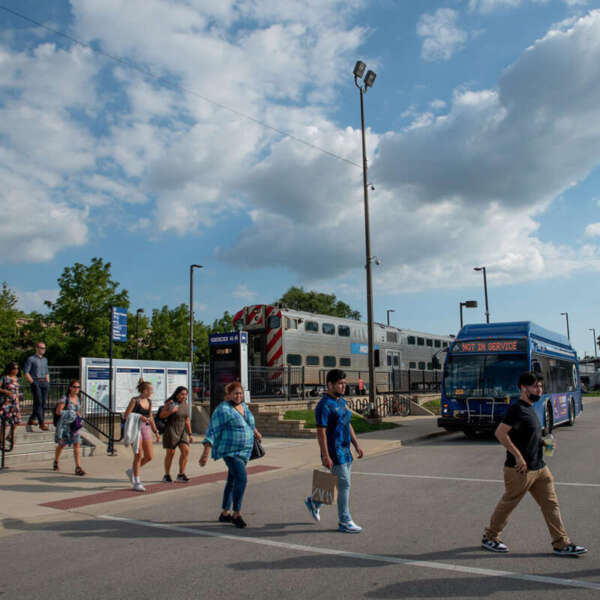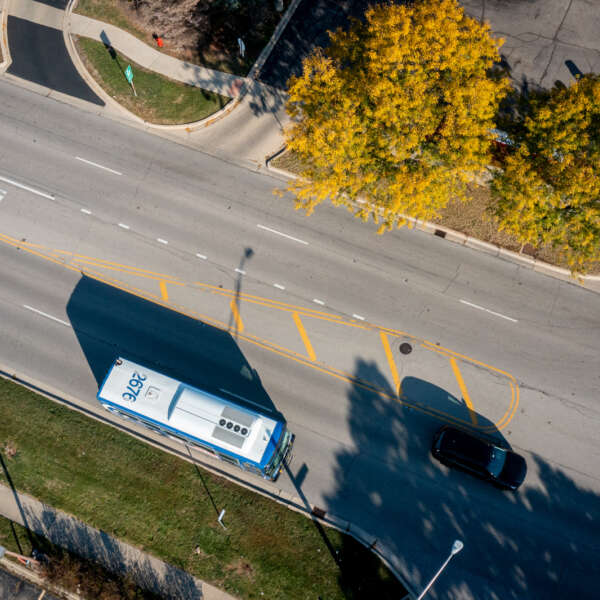RTA to create guide for local governments to enact transit-friendly policies
October 18, 2023
October 18, 2023

Transit can only be as strong as the surrounding built environment — or all the structures and developments that surround a transit station or stop — allows. A certain level of building density and transportation infrastructure is needed for transit to be useful for and well-used by riders. Put another way, areas with a sparse number of buildings, or buildings that all house one type of “use” like offices, or that have limited or poorly connecting sidewalks or roads are not likely to be able to support well-used transit stops or stations.
One advocacy item in Transit is the Answer, the RTA’s regional transit strategic plan, calls on the RTA to support communities’ efforts to improve the area around their transit stations and stops and pursue equitable transit-oriented development (eTOD). The RTA has begun work on a project that will help local governments to enact transit-friendly policies: Transit Friendly Communities: A Guide for Local Governments.
Encouraging transit-friendly policies and investment in walking and biking infrastructure for the more than 200 communities within the RTA region will help improve transportation for all, lower emissions, and is essential to growing ridership. Equitable transit-oriented development (eTOD) is development that enables all people to experience the benefits of dense, mixed-use, pedestrian-oriented buildings and spaces near transit. There is strong evidence that eTOD is particularly important in mitigating the negative effects of gentrification and the impact that unequal housing costs can have.
The RTA’s Community Planning and Access to Transit programs have helped local governments plan for pedestrian-friendly, sustainable communities near transit stations and along transit corridors where residents have access to multiple modes or ways of traveling including transit, biking, walking, and driving. The programs have also helped complete longer-term capital projects that make transit more accessible by foot and bike. Even with these programs, there is still work to be done across the region in continuing to maximize the value of transit and to make sure that there is equitable access to affordable housing near transit.
The RTA will engage partners to develop a regional planning document for communities that host existing or are planning for future transit services. The guide will provide useful tools and standards to help make development and land-use decisions that improve access to transit to ensure that riders and residents of those communities can travel safely and efficiently. The built environment, particularly density and land use, directly impact the level of transit services that can be sustained in a community or corridor. Transit access infrastructure, in the form of sidewalks, crosswalks, bike lanes or paths, and accessibility elements, such as curb ramps and audible pedestrian signal heads, are also instrumental in supporting all forms of transit service. However, decisions about how land is developed lay in the hands of local municipalities, not transit agencies.
This guide is meant to help local decision makers understand the connection between land use typologies — including densities, uses, and access infrastructure — and the range of transit services supported by those typologies. The guide will also provide insight on what transit services are available throughout the region. Recommendations will build off a similar guide completed in 2012, Setting the Stage for Transit, but revise and expand based on changes in the access, mobility, and land development landscape in the past 10+ years. This includes the prevalence of transportation network companies (TNCs) such as Uber and Lyft, micromobility options such as rentable scooters and bikes, and countywide dial-a-ride systems. Some areas of change that will be taken into consideration include:
Development of the Transit Friendly Communities Guide will be supported by a consultant overseen by RTA staff, with significant participation and oversight by a project Steering Committee comprised of representatives of transit agencies, roadway agencies, municipalities, private developers, advocates, and other regional governmental, non-profit, or community-based organizations. Additional outreach, potentially in the form of focus groups, specifically on project recommendations, will also supplement feedback from the project Steering Committee. Monetary compensation will be offered to Steering Committee members and those participating in stakeholder involvement activities.
The project will kick off by the end of 2023, with the final guide expected to be complete within one year.
Transit is the answer to many of the region’s challenges but is threatened by lack of sufficient operating and capital funding after years of disinvestment and a global pandemic. Our region’s current transit funding structure is also overly reliant on fares. Together this leaves our transit agencies to face an existential crisis that neither fare hikes nor service cuts can solve while preserving a useful and equitable system.
We need your help to win sustainable funding for transit and build a better system for everyone who relies on it. Join the Transit is the Answer Coalition to stay informed and advocate for transit.
Subscribe to our Newsletter
Related Articles
 Transit station activation in Uptown brings positive presence to Broadway bus route with weekly outdoor yoga class
Transit station activation in Uptown brings positive presence to Broadway bus route with weekly outdoor yoga class
On Friday mornings now through the end of the year, CTA #36 and #81 bus riders and Red Line passengers through the Uptown neighborhood of Chicago may catch a...
July 25, 2024 Join the RTA Transit is the Answer Coalition to discuss possible reforms to improve service and accountability for riders
Join the RTA Transit is the Answer Coalition to discuss possible reforms to improve service and accountability for riders
Following the introduction of legislation that proposes changes to how the Chicago region’s transit agencies are organized, the RTA continues to lead convers...
July 15, 2024 RTA releases new fare equity report, recommending fully funding and expanding reduced fare programs
RTA releases new fare equity report, recommending fully funding and expanding reduced fare programs
A new report released by the RTA in July, Building a More Equitable Fare Structure for Public Transit in the Chicago Region, recommends that the state legisl...
July 11, 2024 Homewood, Richton Park adopt transit-oriented development plans funded through RTA Community Planning program
Homewood, Richton Park adopt transit-oriented development plans funded through RTA Community Planning program
This spring, transit-oriented development (TOD) plans were adopted by the villages of Homewood and Richton Park that will make these communities more transit...
July 11, 2024 Good news: Regional transit ridership reaches new high as CTA, Metra, and Pace increase service, offer new fare products
Good news: Regional transit ridership reaches new high as CTA, Metra, and Pace increase service, offer new fare products
Ridership across Chicago’s transit system has continued to increase, with May 2024 seeing the highest ridership levels since 2019 for CTA, Metra, and Pace. T...
June 28, 2024 Legislative Update: Lawmakers pass state budget, action on transit funding still needed ahead of fiscal cliff
Legislative Update: Lawmakers pass state budget, action on transit funding still needed ahead of fiscal cliff
The Illinois General Assembly adjourned this year’s spring legislative session after passing an overall $53.1 billion budget for State Fiscal Year (SFY) 2025...
June 27, 2024